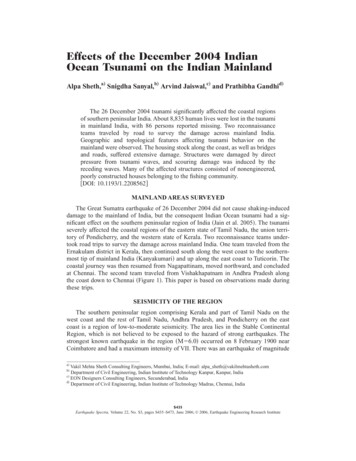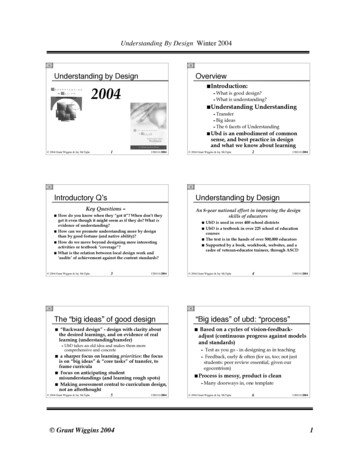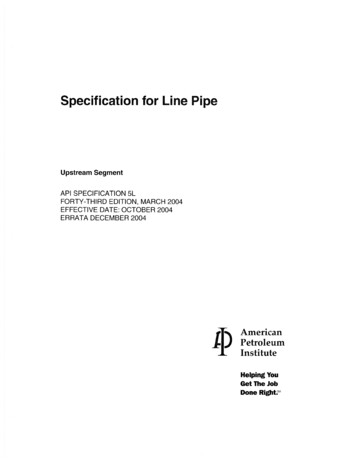
Transcription
Effects of the December 2004 IndianOcean Tsunami on the Indian MainlandAlpa Sheth,a Snigdha Sanyal,b Arvind Jaiswal,c and Prathibha Gandhid The 26 December 2004 tsunami significantly affected the coastal regionsof southern peninsular India. About 8,835 human lives were lost in the tsunamiin mainland India, with 86 persons reported missing. Two reconnaissanceteams traveled by road to survey the damage across mainland India.Geographic and topological features affecting tsunami behavior on themainland were observed. The housing stock along the coast, as well as bridgesand roads, suffered extensive damage. Structures were damaged by directpressure from tsunami waves, and scouring damage was induced by thereceding waves. Many of the affected structures consisted of nonengineered,poorly constructed houses belonging to the fishing community.关DOI: 10.1193/1.2208562兴MAINLAND AREAS SURVEYEDThe Great Sumatra earthquake of 26 December 2004 did not cause shaking-induceddamage to the mainland of India, but the consequent Indian Ocean tsunami had a significant effect on the southern peninsular region of India 共Jain et al. 2005兲. The tsunamiseverely affected the coastal regions of the eastern state of Tamil Nadu, the union territory of Pondicherry, and the western state of Kerala. Two reconnaissance teams undertook road trips to survey the damage across mainland India. One team traveled from theErnakulam district in Kerala, then continued south along the west coast to the southernmost tip of mainland India 共Kanyakumari兲 and up along the east coast to Tuticorin. Thecoastal journey was then resumed from Nagapattinam, moved northward, and concludedat Chennai. The second team traveled from Vishakhapatnam in Andhra Pradesh alongthe coast down to Chennai 共Figure 1兲. This paper is based on observations made duringthese trips.SEISMICITY OF THE REGIONThe southern peninsular region comprising Kerala and part of Tamil Nadu on thewest coast and the rest of Tamil Nadu, Andhra Pradesh, and Pondicherry on the eastcoast is a region of low-to-moderate seismicity. The area lies in the Stable ContinentalRegion, which is not believed to be exposed to the hazard of strong earthquakes. Thestrongest known earthquake in the region 共M 6.0兲 occurred on 8 February 1900 nearCoimbatore and had a maximum intensity of VII. There was an earthquake of magnitudea兲Vakil Mehta Sheth Consulting Engineers, Mumbai, India; E-mail: alpa sheth@vakilmehtasheth.comDepartment of Civil Engineering, Indian Institute of Technology Kanpur, Kanpur, Indiac兲EON Designers Consulting Engineers, Secunderabad, Indiad兲Department of Civil Engineering, Indian Institute of Technology Madras, Chennai, Indiab兲S435Earthquake Spectra, Volume 22, No. S3, pages S435–S473, June 2006; 2006, Earthquake Engineering Research Institute
S436A. SHETH, S. SANYAL, A. JAISWAL, AND P. GANDHIFigure 1. Reconnaissance team survey routes covering the mainland. 共Map courtesy ofC. V. R. Murty兲M 5.8 on 31 March 1843 in Bhadrachalam, Andhra Pradesh. Earthquakes of magnitudeM 5.5 共1959兲 and M 5.2 共1967兲 occurred at Ongole, Andhra Pradesh. Figures 2 and 3indicate the broad shield sources and tectonic features of the peninsular shield of India共Rao 1970, Reddy 2004兲.In the last decade, the area has experienced earthquakes of magnitude 5.0 and lower.The most recent significant earthquakes were M 5.0 共2000兲 and M 4.8 共2001兲, both ofwhich occurred in the same area south of Idukki in central Kerala.TSUNAMI HISTORYPrior to 26 December 2004, there was no known record of tsunamis on the southwestcoast of India. The west coast experienced a tsunami due to the M 8.1 earthquake of 27November 1945 with an epicenter 100 km from Karachi, Pakistan, but the effects werefelt only up to Karwar, 250 km north of the Kerala border. The southeast coast, however,has experienced tsunamis earlier. The earliest record dates back to 31 December 1881,when a tsunami 1 m high was recorded in Chennai. It was caused by an earthquake ofM 7.9 below Car Nicobar Island. The August 1883 eruption of the Krakatoa volcano inIndonesia caused 2-m-high tsunami waves in Chennai. On 26 June 1941, an M 8.1earthquake occurred in the Andaman archipelago, which triggered a tsunami of about
EFFECTS OF THE DECEMBER 2004 INDIAN OCEAN TSUNAMI ON THE INDIAN MAINLANDS437Figure 2. Tentative broad shield sources in the peninsular shield for India 共source: I. Gupta兲.1 m in the city of Chennai. While some scientists have estimated deaths of over 3,000people along the east coast of India in the 1941 tsunami, there are no reliable data on thenumber of deaths, if any, due to that tsunami 共Murty and Rafiq 1991, Bilham 2005兲.GEOLOGY OF COASTAL MAINLAND INDIAThe structure of peninsular India is complex because of the varied geology, faults,and fractures. More than a third of this area is covered by basaltic flows called the Deccan Trap. The thickness is 2 – 3 km on the west coast and decreases toward the east. Therest of the peninsula is covered by Precambrian rocks and sedimentation formation oflater eras 共Figures 2 and 3, Gupta 2005兲.The soil along the west coast of Kerala and Tamil Nadu is primarily sandy, underlainby soft clay layers. Further south, away from the coastline, the land slopes steeply upward and is rocky. The coastal strip of southwest Tamil Nadu is rich in minerals. There
S438A. SHETH, S. SANYAL, A. JAISWAL, AND P. GANDHIFigure 3. Major evolutionary units and associated tectonic features in peninsular India 共source:I. Gupta兲.has been significant dredging in the mineral-rich Kanyakumari coast, and this has led toa change in the topology of the area by flattening some areas and making them morevulnerable to a tsunami.The east coast has rich alluvial soil in the river deltas and along the coast. The otherpredominant soils in this region are clay, loam, and red laterite. Along the AndhraPradesh coast, the soil is also rich alluvial with rocky outcrops but, in certain pockets ofthe delta areas of Godavari, the soil is deep friable, well-drained sandy loam.WAVE ARRIVAL TIMEThe tsunami waves arrived first on the east coast. Details of the tide gauge levels atthe ports of Kochi, Tuticorin, Chennai, and Vishakhapatnam are shown in Figures 4–7
EFFECTS OF THE DECEMBER 2004 INDIAN OCEAN TSUNAMI ON THE INDIAN MAINLANDS439Figure 4. Tide gauge data for Kochi Port 共source: NIO兲.共NIO 2005兲, respectively. As can be seen from the tide gauge data, the tsunami wavesfirst reached Kochi at 11:10 A.M., Tuticorin at 9:57 A.M., and Chennai and Vishakhapatnam at 9:05 A.M. 共all Indian Standard Time兲.Most locations experienced 3–5 waves, details of which are described elsewhere inthis paper.GENERAL FEATURES OF TSUNAMI EFFECTSThe tsunami effects varied greatly across different parts of the coast according to thenumber of waves experienced, inundation distance and height of the waves, and densityof the area—as well as topological and geographical features that made some areas morevulnerable than others 共Table 1兲. The number of lives lost was also influenced by theproximity of habitats to the coastline, exposure to previous disasters, and the local disaster management capability. These are discussed in detail in this paper. The affectedareas are discussed in three parts, which are based on their geography:
S440A. SHETH, S. SANYAL, A. JAISWAL, AND P. GANDHIFigure 5. Tide gauge data for Tuticorin Port 共source: NIO兲. Southwest coast: this comprises Kerala, which suffered significant damage that im- pacted the largest number of people of any affected state but suffered relatively lowerloss of life, and the Kanyakumari district of Tamil Nadu, which suffered heavy lossof life due, to a large extent, to human-created local topographical features.Southeast coast: this comprises the rich alluvial delta region of the Tamil Nadu coastand Pondicherry, which experienced maximum wave heights and recorded the maximum loss of life and damage in mainland India.East coast: this comprises Andhra Pradesh, which suffered marginal damage and lossof life.
EFFECTS OF THE DECEMBER 2004 INDIAN OCEAN TSUNAMI ON THE INDIAN MAINLANDS441Figure 6. Tide gauge data for Chennai Port 共source: NIO兲.GEOGRAPHIC AND TOPOLOGICAL FEATURES AFFECTING TSUNAMIBEHAVIOR ON THE MAINLANDSOUTHWEST COAST OF MAINLAND INDIAKeralaThe state of Kerala experienced tsunami-related damage in three southern districts,Ernakulam, Allapuzha, and Kollam 共Table 2兲, due to the diffraction of the waves aroundSri Lanka 共Murty 2005兲. The southernmost district of Thiruvananthpuram, however, escaped damage. This was possibly due to the wide turn of the diffracted waves at the peninsular tip, thereby missing Thiruvananthpuram.The coast of Kerala is relatively flat and practically at sea level. Throughout thecoastal areas of Kerala, and especially in the affected districts, are long stretches oflakes, lagoons, and ponds connected by a network of canals called “backwaters” 共kayals兲. The backwater routes date from centuries ago and have long been used for all trans-
S442A. SHETH, S. SANYAL, A. JAISWAL, AND P. GANDHIFigure 7. Tide gauge data for Vishakhapatnam Port 共source: NIO兲.portation needs, in particular for trade in coconut, rubber, rice, and spices. Today, thesewaterways link remote villages and islands to the mainland.Major damage in Kerala occurred in two narrow strips of land bound on the west bythe Arabian Sea and on the east by a network of backwaters.Ernakulam DistrictThe northern strip comprises the island of Wypeen north of the city of Kochi in theErnakulam district. It is about 20 km long and has a maximum width of about 3 km.Edavanakkad is a prominent fishing village in Wypeen Island that suffered maximumdamage. Fifty houses were completely destroyed 共Figure 8兲, and 350 houses were damaged in this village, which lost 5 lives. The coast in this area had a seawall along mostparts, with openings in the seawall for the passage of boats. Damage due to the tsunamiwas more intense in the areas that were not protected by the seawall. At Edavanakkad,the seawall was about 100 m from the shoreline and was made of random loose rubble
Coastallengthaffected共km兲Waterpenetration intomainland共km兲Averageheight oftsunami wave*共m兲Max.runupheight共m兲Kerala2500.5 1.53 53.4Tamil Nadu共west coast兲Tamil Nadu共east ndicherry250.2–249850.2–1.05–10共max. atKaraikal兲4State orunionterritoryAndhraPradesh*2.2Human lives lost,per shnaNellorePrakashamOtherNumber Dwellingunits lostor 1,557EFFECTS OF THE DECEMBER 2004 INDIAN OCEAN TSUNAMI ON THE INDIAN MAINLANDTable 1. Tsunami effects in mainland India 共source: Ministry of Home Affairs兲Based on survivors’ estimatesS443
S444A. SHETH, S. SANYAL, A. JAISWAL, AND P. GANDHITable 2. Characteristics of tsunami waves in KeralaWave InundaWave traveltionheight distance height共m兲共m兲共m兲DistrictNo. ofwavesArrival timeof wavesErnakulam3First wave at11:10 A.M.,second wave at1:30 P.M.,third wave at1:45 P.M. 4 1,0002.4Allapuzhaand Kollam3First wave at11:30 A.M.,second wave at1:40 P.M.,third wave at1:45 P.M. 4 1,0003SpecialfeaturesRecession ofwaterWater level Water recededrose from about 150 m into10:30 A.M. sea after first wave;when water receded, it took a lotof sand andscoured roads.—Water receded 500 m before firstwave.masonry comprising large boulders, some of which were displaced by the tsunami. Thehouses in Edavanakkad were built about 15 m from the seawall. The plinth height wasabout 0.6 m from mean sea level.Allapuzha and Kollam DistrictsThe other strip most affected in Kerala is a shoestring isthmus south of the city ofAllapuzha about 40 km long and extending from Trikunnapuzha in the Allapuzha district to Karunagapalli in the Kollam district. The strip has a maximum width of less than1 km and is bound by the open coast on the west and Kayanakulam Lake and backwaters on the east. A small opening in the strip connects the lake to the sea. The width ofthe land strip is less than 0.5 km at many places. As a result, the tsunami waves lashedover the entire strip of land, traveled across the backwaters, and rolled onto the oppositebank.Two areas that bore the brunt of the tsunami in the region were Arattupuzha in theAllapuzha district and the Alappad panchayat in the Kollam district 共Figures 9 and 10兲.These areas are the gatekeepers of the opening where the lake disgorges into the sea. Thevillages are densely populated 共with a density of 2,652 per km2, versus the state averageof 762 per km2兲 on both sides of the coastal road that barely separates the lake from thesea. The isthmus has no intermediate bridge connection to the mainland and is connected to it only at the two ends. The area thus has to depend on boats for safe exit intimes of emergency. The largest number of casualties 共130兲 in Kerala was reported fromthe densely populated Alappad panchayat 共including the villages of Cheriya Azhikkaland Azhikkal兲. In the village of Arattupuzha in the Allapuzha district, the death toll was28. The seawall, where it existed, was dislodged and did not exist in many places along
EFFECTS OF THE DECEMBER 2004 INDIAN OCEAN TSUNAMI ON THE INDIAN MAINLANDS445Figure 8. Damaged house in Edavanakkad 共photo: A. Sheth兲.the north Kollam coast. A wave height of 4 m was reported by the survivors.The area has a history of floods that occur during the monsoon, especially whenheavy rains coincide with high tide. The villagers are thus well trained in quick and safeevacuations, but there was simply no time for evacuation in these densely populated villages when the tsunami arrived. There was, however, no loss of life in villages such asWalia Azhikkal, where rapid evacuation was carried out successfully. After observationsof abnormal behavior of the sea, the Kerala police had sounded an alert at 11:30 A.M. towarn people, but it was too late for some villages. The tsunami struck almost immediately afterward.Tamil NaduKanyakumari forms the southwest district of Tamil Nadu. Unlike the Kerala coast,the Tamil Nadu west coast has flat land at sea level along the north coast in some areassuch as Kolachel, where the soil is rich alluvium, but in other areas and further south,the land is mountainous. It slopes steeply upward from the coastline and is rocky. This
S446A. SHETH, S. SANYAL, A. JAISWAL, AND P. GANDHIFigure 9. Scouring in Allapuzha—houses were 4 – 15 m from the shoreline 共photo: A. Sheth兲.was observed at Muttom Beach and at the tip of Kanyakumari. On some beaches such asSothavilai, there are sand dune formations. Table 3 summarizes the tsunami wave characteristics in Tamil Nadu.Kanyakumari DistrictOne of the most affected areas in the district was Kolachel and the surrounding villages, located 30 km west of Nagercoil, which is the capital of the Kanyakumari district.The land near the coast is flat and is at sea level, and no seawall was visible. Water traveled inland by more than 300 m. New streams and estuaries were carved out by incoming waves 共Figure 11兲. When the waves receded, they deepened these features further byscouring. The town and neighboring villages recorded more than 500 fatalities, of whichmore than 50% were children. The wave height was reported to be 5 m, and the runupheight was 2.6 m 共Figure 12兲. A large number of deaths were triggered by the humancreated topology of this town. Harbour Road, which experienced the maximum numberof casualties, had a long, open, dry channel called the Ananda Victoria Marthandam共AVM兲 Canal 共Figure 13兲. This canal is more than 2.5 m deep and 6 m wide, runningparallel to the shore. The canal was meant to bring in fresh water but was not in use.Besides this canal, there were numerous open trenches laid parallel to each other 共Figure14兲 that catered to the special needs of the coir-making industry, which is the mainmeans of livelihood in this region besides fishing. These trenches were about 1.5–2 mdeep, 15 m long, and 4 m wide. They were used to soak the coconuts and separate the
EFFECTS OF THE DECEMBER 2004 INDIAN OCEAN TSUNAMI ON THE INDIAN MAINLANDS447Figure 10. Destruction in the Allapad panchayat—a concrete block house with a reinforcedconcrete 共RC兲 roof 共photo: A. Sheth兲.husk for making coir. When the tsunami waves surged into the town, the AVM canal andthese trenches became death traps. More than 300 bodies were recovered from the slushof the trenches and channel. The masonry retaining wall of the jetty at Kolachel wasbadly damaged.A few kilometers from Kolachel is Muttom Beach, a popular tourist spot in TamilNadu often used as a romantic backdrop by the bustling Tamil film industry. This areadid not suffer damage, because it is more than 50 m above mean sea level. A few touristswho had gone down to the sea to watch the tsunami were washed away in the wave at10:30 A.M.The Mannakudi panchayat near Kolachel was a cluster of villages, including Melamanakudi, which was badly affected. A 160-m-long bridge had been commissioned in
S448A. SHETH, S. SANYAL, A. JAISWAL, AND P. GANDHITable 3. Characteristics of tsunami waves in Tamil NaduDistrictNumber ofwavesArrival time of wavesWaveRunupheight Wave travel height共m兲 distance 共m兲 共m兲Water conditionbefore/after tsunamiWater recededabout 1 km beforefirst wave in areassuch as SottavellaiKanyakumari3First wave 10:30 A.M.and second and thirdwave at 15-min. intervals after first4–10 200– 4002.4Nagapattinam5First wave at 9:00A.M.; five waveswithin 1-hr span 10100–1,0005Cuddalore3First wave at 8 A.M.and subsequent wavesat 10– 15-min. intervals 92504Kancheepuram3First wave at 9:15 A.M. 4 1,0002Chennai5First wave at 9:05 A.M.and fifth at 11 A.M.-20022002 to connect the villages of Melamanakudi and Kelamanakudi on opposite banks ofthe Pazhyar River. The bridge went missing after the tsunami 共Figure 15兲. It was originally built with four spans, all of which were washed away by the tsunami. The two endspans traveled upstream by 100 m and were beached on the banks; the central spanswere not visible, apparently having sunk into the waters. The substructure appeared to beintact except at the apron. There were no restraints between the superstructure and thefoundation. Melamanakudi is a prosperous and picturesque hilly village built on the waterfront. A road from the village of Palam to Melamanakudi was reportedly built by leveling the sand dunes in the region, in violation of the coastal regulation zone 共CRZ兲rules. Numerous houses were built on the seashore not more than 50 m from the shoreline, apparently after the leveling of sand dunes. These houses suffered complete devastation 共Figure 16兲. Structures 250 m from the shoreline suffered little or no damage, because the land sloped upward. About 150 people died at Melamanakudi.Sothavilai has a beautiful beach and was being actively developed by the state fortourism. The beach slopes upward from the shoreline and folds into sand dunes about8–10 m high along parts of the beach. A beach resort has been constructed inland beyond the sand dunes. Numerous tea shops and other food stalls lined the path leading tothe beach. The tsunami waves lashed and made their way over the ridges of these dunesand beyond them through the numerous small drainage channels running into the seafrom the town, causing loss of life and much scouring while receding. An estimated 200people, mainly stall owners and visitors, died at this beach.
EFFECTS OF THE DECEMBER 2004 INDIAN OCEAN TSUNAMI ON THE INDIAN MAINLANDS449Figure 11. The tsunami carved new waterways—a soak pit was exposed by tsunami waves inKolachel 共photo: A. Sheth兲.The southernmost tip of mainland India, Kanyakumari, experienced tsunami wavesthat were over 4.5 m high. Because Kanyakumari is on high land, the damage waslimited—street furniture and compound walls were destroyed. About 1,200 peoplestranded at the rock memorial were successfully evacuated a few hours after the tsunami.SOUTHEAST COAST OF TAMIL NADU AND PONDICHERRYThe southeastern coastline of Tamil Nadu is 800 km long. It comprises the Coromandel Coast in the north and the Fisheries Coast in the south. The coast north of PointCalimere up to Pondicherry is practically straight 共 79.5 E兲 and directly across from
S450A. SHETH, S. SANYAL, A. JAISWAL, AND P. GANDHIFigure 12. The runup height at Kolachel Beach was 2.6 m, as shown by the watermarks 共photo:A. Sheth兲.the Andaman and Nicobar Islands at a distance of 1,900 km. This region was the mostaffected by the tsunami. It comprises the coastal districts of Nagapattinam, Cuddalore,Villipuram, Kanchipuram, and Chennai.The arrival of the first tsunami wave along the east coast coincided with high tide,which amplified its effect, as seen in Figure 6. The coastline in this region is flat exceptfor gentle slopes. From local residents, it was inferred that the beaches previously had asteeper slope than is now visible. Many of the slopes and much of the vegetation havebeen cut during the last two decades to make way for coastal hamlets.The coastal districts of Tirunelveli, Tuticorin, Ramanathapuram, and Pudukkotai—which were in the shadow zone of Sri Lanka—suffered relatively minor effects from tsunami waves. The tide gauge at Tuticorin Port, for example, measured a wave height of1.8 m, which was only marginally higher than high-tide levels, partly because the tsunami waves were out of phase with the high tide here 共Figure 5兲.Nagapattinam DistrictNagapattinam was the most affected district, not just in Tamil Nadu but in the entiremainland of India, with 6,051 fatalities reported. Some social factors added to the vulnerability of the region.VelankanniThe town of Velankanni, 12 km from Nagapattinam, houses the Church of Mary of
EFFECTS OF THE DECEMBER 2004 INDIAN OCEAN TSUNAMI ON THE INDIAN MAINLANDS451Figure 13. The AVM channel in Kolachel, which became a death trap; more than 300 bodieswere found in the slush of the AVM channel and open trenches 共photo: A. Sheth兲.Figure 14. Open trenches for making coir. As with the AVM channel, these trenches also became death traps 共photo: A. Sheth兲.
S452A. SHETH, S. SANYAL, A. JAISWAL, AND P. GANDHIFigure 15. All spans of the Melamanakudi Bridge came off their bearings. The end spansdrifted upstream, while the middle spans sank into the river 共photo: A. Sheth兲.Good Health and is a very popular pilgrimage center among believers for its healingpowers. The central axis of the church is aligned with the main road leading to the beach共Figure 17兲. Thousands of worshippers had thronged to this town for Christmas, andmany of them were at the beach on the morning of 26 December after attending Mass.More than 2,000 people died in this town. A tsunami wave approximately 5 m high firststruck the shore at 9:20 A.M., followed by four more waves between 9:20 A.M. and 10A.M. The waves crashed onto the shore and continued on their rampage along the mainroad leading to the town. Though the water did not enter the church, it gushed up to thebus stand, inundating several shops and houses. A large number of bodies were foundalong this road. The inundation distance was more than 1,000 m.SeruthurIn the adjacent coastal village of Seruthur, which lost 131 people, the wave heightwas the same as in Velankanni. The number of deaths was lower because of much lowerpopulation density, but also because the plinth of the houses in this village was 1.5 mabove ground level, and the elevation of the ground was 1.5 m from sea level. The runupheight was 2 m above the plinth level, or 5 m above mean sea level 共Figure 18兲.AkkaraipettaiAkkaraipettai is an important and prosperous fishing port in the Nagapattinam district. About 1,000 boats and fishing trawlers were destroyed in this town.
EFFECTS OF THE DECEMBER 2004 INDIAN OCEAN TSUNAMI ON THE INDIAN MAINLANDS453Figure 16. Some homes at Melamanakudi were within 6 m of the shoreline. This photo showsa fallen RC roof slab 共photo: A. Sheth兲.On Ariyanattu Street, a communications tower 共Figure 19兲 and control room 共Figure20兲 had toppled, while in adjacent Naliyanthottam, a godown 共warehouse兲 storing gascylinders was destroyed, with all cylinders being swept away by the tsunami. Thegodown was more than 800 m from the shoreline.NagoreNo damage was reported at the oil jetty at Chennai Petrol Chemicals Ltd. at Nagore,primarily because of the high elevation, more than 3 m from sea level. However, 1,200houses were destroyed or damaged. Water entered almost 1,000 m inland. The rail linkto Nagore, a pilgrim town, was cut off as a 7-km meter-gauge track between Nagapattinam and Nagore was completely damaged 共Figure 21兲.Cuddalore DistrictThe Cuddalore district borders Nagapattinam in the north and was the second-mostaffected district.Silver BeachSilver Beach had been recently developed for tourism and recreation activities, suchas boating and a small amusement park. Two rivers discharge into the sea at this sceniclocation. The shore is at sea level. The first tsunami wave arrived at 8:35 A.M., with twosubsequent waves within the next 15 minutes. The waves threw boats upstream into the
S454A. SHETH, S. SANYAL, A. JAISWAL, AND P. GANDHIFigure 17. Velankanni—maximum loss of life along the road from the beach leading to thechurch 共source: www.vailankannichurch.org兲.Figure 18. Houses in Seruthur, the village neighboring Velankanni, were not significantly affected, due to a higher plinth 共photo: A. Sheth兲.
EFFECTS OF THE DECEMBER 2004 INDIAN OCEAN TSUNAMI ON THE INDIAN MAINLANDS455Figure 19. Damaged communication tower on Ariyanattu Street 共photo: A. Sheth兲.rivers and subsequently onto the shores. The waves destroyed most of the small structures built on the beach, such as a police booth, a boat house, water tanks, and electricitypoles. The newly built road was washed away completely 共Figure 22兲, as was the newNeyveli Lignite Corporation 共NLC兲 amusement park. The road had been built afterFigure 20. Toppled control room on Ariyanattu Street 共photo: A. Sheth兲.
S456A. SHETH, S. SANYAL, A. JAISWAL, AND P. GANDHIFigure 21. Damaged railway line between Nagore and Nagapattinam 共photo: A. Sheth兲.clearing away mangroves. The water remained about 0.6 m above mean sea level forfour days after the tsunami. On the beach, 37 people died. Bodies of victims were foundin fishing nets, mangrove bushes, and in low-level areas. The bodies were covered withsand deposited by the waves. Adjacent thatched houses of a village less than 1 km fromthe shore were not damaged. Survivors reported a wave height of 6 m.DevanampattinamThis is a coastal fishing village not far from Silver Beach, built barely 50 m from theshoreline at sea level. Unsurprisingly, houses were significantly damaged 共Figure 23兲.
EFFECTS OF THE DECEMBER 2004 INDIAN OCEAN TSUNAMI ON THE INDIAN MAINLANDS457Figure 22. Tsunami waves washed away the newly built roads at Silver Beach, Cuddalore共photo: A. Sheth兲.TalangudaIn the coastal village of Talanguda, houses were also built about 50 m from theshoreline, but, because of a tree grove between the sea and the houses, the damage wasFigure 23. Houses in Devanampattinam were barely 50 m from the shoreline 共photo: A. Sheth兲.
S458A. SHETH, S. SANYAL, A. JAISWAL, AND P. GANDHIFigure 24. At Singarathop, the bridge from which this photo was taken is much higher than thetown and served as a refuge 共photo: A. Sheth兲.in some measure contained, even though the tsunami waves were said to be more ferocious here than at Devanampattinam. The gable walls of most thatch houses had sufferedmajor damage or had collapsed. The waves had lashed the boats across the beach, andsome boats had crashed against houses from the gaps between trees. However, not asingle nonengineered structure with a concrete roof was affected.SingarathopSingarathop was a fishing village with a flowing river. A new bridge connects thetown of Cuddalore to Singarathoppu. The tsunami, coupled with the high tide level ofthe river, caused a severe rise in water level, and the whole town was submerged. Therecently constructed bridge had a very high elevation, and residents rushed to thisbridge, thus saving their lives 共Figure 24兲.Kancheepuram DistrictThe Kancheepuram district has special significance because of the presence of thenuclear power plant at Kalpakkam. The plant area was not affected by the tsunami; however, the housing colony 共DAE township兲 was very badly affected. Almost 1,000 houseswere damaged, and a seawall 2 m high and 4 km long collapsed. The waves rushed intothe colony, with a runup height of about 1.5 m. Almost all courtyard walls of the housesfor 1 km collapsed. There was almost no vegetation near the shore. A new estuary wasformed. A school’s compound wall was damaged, and electric poles were uprooted nearthe school grounds. The tsunami waves deposited a large quantity of sand near a pedestrian bridge. Water pipelines along the bridge were thrown off the bridge.
EFFECTS OF THE DECEMBER 2004 INDIAN OCEAN TSUNAMI ON THE INDIAN MAINLANDS459Figure 25. The foundation pit of this 500-MW reactor was inundated by 6 m of water 共photo:P. Gandhi兲.A foundation of 100 100 m for a 500-MW fast breeder reactor was being constructed about 500 m from the sea. The foundation’s pit, which was 20 m deep, was inundated by 6 m. From an observation post, a vigilant project officer had seen the tsunami wave striking the compound wall and warned the 180 people in the pit toimmediately evacuate; as a result, there were no casualties. Also, the people had enoughtime to escape because of the time required for the water to fill the foundation pit 共Figure 25兲.ChennaiAt about 13 km in length, Marina Beach in Chennai is the second-longest beach inthe world. Numerous stately structures facing Marina Beach were built in colonial times.The tsunami b
Tamil Nadu west coast 100 0.2–2.0 3–10 4.5 824 Kanyakumari 376 0.9 128,394 Tamil Nadu east coast 800 0.4–1.5 2–10 5 6,051 Nagapattinam 612 Cuddalore 128 Kancheepuram 206 Chennai 144 Other Pondicherry 25 0.2–2 5–10 max. at Karaikal 4 484 Karaikal 107 Pondicherry 33 0.04 10,061 A











